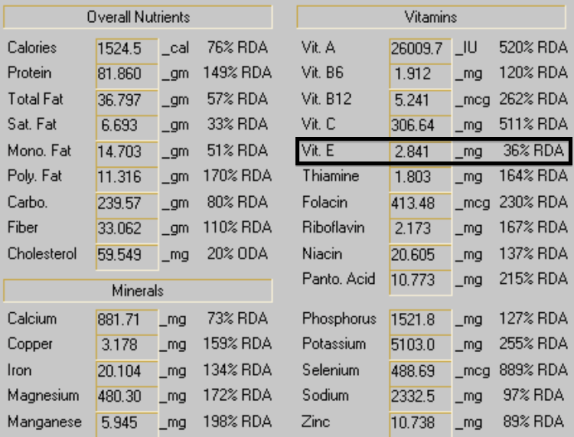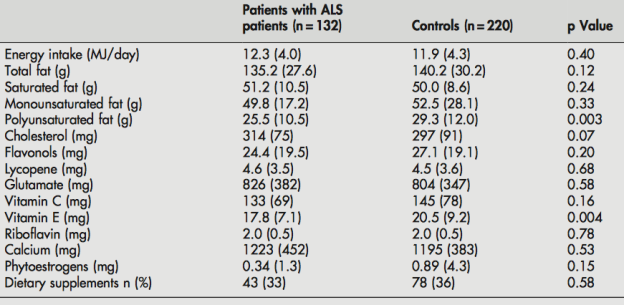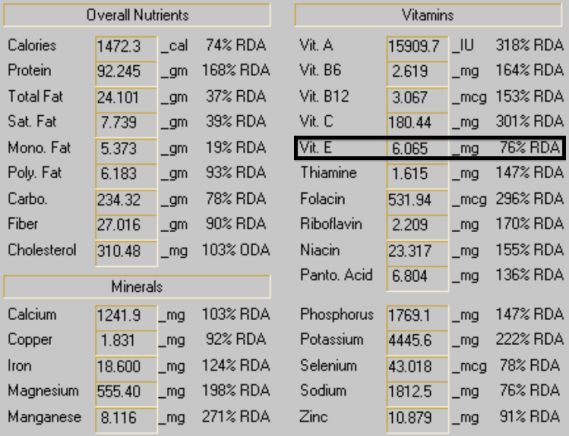With the goal of improving health and extending lifespan, Roy Walford was a pioneer in terms of studying (and implementing) a diet that is calorie restricted but that also contains optimal nutrition (CRON). Unfortunately, Walford died at age 80 from complications related to Amyotrophic Lateral Sclerosis (ALS). Were there any factors in his nutritional approach that increased his risk for developing ALS?
On Walford’s website, http://www.walford.com, he listed 2 sample days of both food intake and his resulting macro- and micronutrient composition:

Although several micronutrients (calcium, sodium, zinc) are below the RDA on day 1, Walford’s 2-day average bring these values close to the RDA. However, his Vitamin E intake on day 1 and day 2 (shown below) are glaringly deficient. On day 1, his Vitamin E intake was only 2.8 mg. On day 2, it was 6.1 mg, for a 2-day average value of 4.5 mg. The RDA for Vitamin E was updated in 2000 (Food and Nutrition Board, 2000) from 8 mg to the current 15 mg-he wasn’t close to either value!
Dietary Vitamin E has been reported to be decreased in patients with ALS, when compared with ALS-free controls, as shown below (Veldink et al. 2007). Although the subjects of Veldink et al. had an increased calorie intake when compared with Walford (2842 and 2938 calories in controls and in ALS patients, respectively), when scaled down to Roy’s 1500 calorie intake, a dietary Vitamin E intake of 9 mg would be found in ALS patients, with 10.8 mg found in the controls. For comparison, Walford’s 2-day Vitamin E intake was only 6.1 mg! Interestingly, the only other dietary nutrient category that was significantly different between ALS patients and controls was polyunsaturated fat (PUFA) intake, which was also low (8.8g) in Walford’s 2-day diet.
I’m not at all saying that Walford’s dietary deficiencies in Vitamin E and PUFA caused his ALS. It’s also unknown whether the 2 days that he posted on his website are representative of his overall CRON approach. But it’s an interesting observation, isn’t it?
If you’re interested, please have a look at my book!
https://www.amazon.com/dp/B01G48A88A?ref_=k4w_oembed_omIChDjq2EkggX&tag=kpembed-20&linkCode=kpd
References
Food and Nutrition Board, Institute of Medicine. Vitamin E. Dietary reference intakes for vitamin C, vitamin E, selenium, and carotenoids. Washington, D.C.: National Academy Press; 2000:186-283.
Freedman MD, Kuncl RW, Weinstein SJ, Malila N, Virtamo J, Albanes D. Vitamin E serum levels and controlled supplementation and risk of amyotrophic lateral sclerosis. Amyotroph Lateral Scler Frontotemporal Degener. 2013 May;14(4):246-51
Veldink JH, Kalmijn S, Groeneveld GJ, Wunderink W, Koster A, de Vries JH, van der Luyt J, Wokke JH, Van den Berg LH. Intake of polyunsaturated fatty acids and vitamin E reduces the risk of developing amyotrophic lateral sclerosis. J Neurol Neurosurg Psychiatry. 2007 Apr;78(4):367-71.



2 examples is not very much. Does your theory hold up against the recipes posted on his website and in his books? Its possible those days just happen to be without spinach and tomatoes and other Vit. E rich vegetables.
Also he seems on par with the average intake (http://jn.nutrition.org/content/136/4/1021/T3.expansion.html) even though he eat a lot less calories.
LikeLiked by 1 person
Yes, 2 dietary deficiencies may not seem like much, especially considering that Walford’s Vitamin E intake was close to the US average. But consider this: low levels of PUFA and Vitamin E were found to be synergistically associated with increased ALS risk:
http://www.ncbi.nlm.nih.gov/pubmed/16648143
LikeLike
Also, as someone who popularized CRON, why would Walford post 2 sample days filled with deficiencies on his website?That’s not at all CRON, and it’s that lack of attention to detail that we can all improve upon, imo.
LikeLike
Just reading his book despite it being somewhat date. Did you overlook his recommendation that one should take vitamin E and selenium supplements to significantly exceed RDA’s of these two.
LikeLike
I didn’t, but how long did he live before those recommendations? One can easily cover the RDA for these nutrients from diet alone.
LikeLike
What do you suggest to eat to get enough Vit E? I’ve been trying to set up a more vegetable heavy (vegan) diet and have been falling short on Vit E. I know almonds have a lot, but anything besides almonds and spinach?
LikeLike
Broccoli, butternut squash, carrots, and red peppers are great sources of Vitamin E.
LikeLike
Pingback: The age old anti-ageing Saga: Can termites and monkeys give us answers? – Science hits the Bull's-eye
I had a book of Roy Walford (I believe his first) from the 1980’s were he states the supplements he was taking and Vitamin E was one of them. Therefore, I believe he was supplementing Vitamin E 15 to 20 years before he joined the choir invisible.
LikeLike
if we follow the Ray Peat research, the premature death of Roy Walford is easily explained:
– too high intake of pufa compared to low dose of vitamine e (vitamine e protects the oxydation of pufa)
https://raypeat.com/articles/articles/unsaturatedfats.shtml
-too high phosphate/calcium ratio, which accelerate aging
http://raypeat.com/articles/articles/phosphate-activation-aging.shtml
– too high protein intake unbalanced with glycine
https://raypeat.com/articles/articles/gelatin.shtml
LikeLike
To add a caveat, it’s unknown how much diet contributed to Roy’s demise. Was the oxygen poor environment in Biosphere 2 the primary cause? We’ll never know…
LikeLike